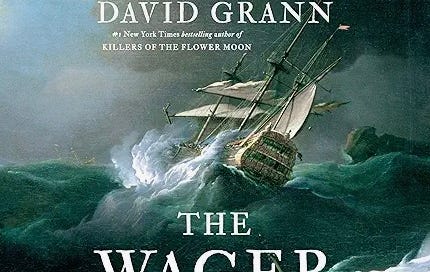BookLife Review by Carol O’Day: The Wager, A Tale of Shipwreck, Mutiny and Murder (David Grann, author)
Non-fiction, British naval history, shipwreck, murder, mutiny, colonialism, sailing, meteorology, naval journals and logs, military order, ship-building, adventure, scurvy, ingenuity
Step back in time to the 1700’s when British naval exploration and piracy were a part of nation wealth-building. The Wager, a tale of Shipwreck, Mutiny and Murder, is a deeply researched work of non-fiction that reads like a fictional Robinson Caruso adventure and survival story. It is rife with life-threatening storms at sea, fatal illness and injury, ambition, tragedy, murder and courtroom drama. Author David Grann relies on British naval records, seamen’s logs and journals, archival nautical and weather records and news reports, and his own gift for storytelling. The Wager was a British man-of-war vessel converted into naval service after its former stint as a merchant vessel. In the eighteenth century, naval ships were constructed of oak and were regularly refitted not only between service missions but all along the way, carrying with them a team of carpenters to make or rig repairs as the ships encountered punishing storms on their routes.
In 1740, the Wager was ready to set sail under the leadership of Captain David Cheap, a Scotsman promoted to his first captaincy and under the command of Commodore George Anson of the lead ship, The Centurion. The King of England order the commanders of the ships to track down and plunder a Spanish galleon which was believed to have pirated gold and other treasure from other vessels. This planned act of aggression and theft was premised on a marginally justified previous sleight the British Navy had suffered at the hands of the Spanish. Ships of this magnitude required hundreds of seamen and in the heyday of the British naval expeditions, seamen were hard to come by. As a result, seamen on leave, prisoners and even civilians walking about seafaring cities were often conscripted, even kidnapped, and pressed into service to form the necessary crew.
After an extended period of construction and conscription, The Wager, along with The Centurion and other vessels at long last set sail from Portsmouth, England on a journey slated to round Cape Horn at the foot of South American and continue along to the coast of Chile where it the cohort expected to intercept the Spanish galleon. The journey required the ships to traverse perilous and often deadly waters, currents and storms that brewed without much respite around Cape Horn. Along the route, almost half of the crew succumbed to disease, injury and most significantly scurvy. In that era, the cause of the illness now known as scurvy was not understood as a lethal deficit of vitamin C triggered by the unbalanced diet experienced aboard ships. The fatalities numbered in the hundreds and as it progressed the ships grew shorter on manpower even as they neared the most treacherous stretches of the trip.
Despite surviving the hurricane-like storms around Cape Horn, The Wager crashed into the rocky shores of Chile and was shipwrecked. Shelter was hard to come by, food stores were minimal and dwindled quickly, and hunting opportunities were few and far between. Havoc ensued in Lord-of-the-Flies fashion. Hunger and illness, and fear and frustration mounted, and unrest percolated among the ranks. A faction of food and weapons thieves were banished to a remote sub-island and Captain Cheap executed one a traitor. Dissatisfaction with Captain Cheap rose, loyalties splintered, and a contingent of seamen looked to a navigator, John Bulkeley, around whom a following grew.
The splinter group around Bulkeley began construction of a small craft from remnants of The Wager and proposed to sail back through the Strait of Magellan rather than again around Cape Horn in the open sea and to attempt a landing on the coast of Brazil for rescue. Captain Cheap rejected that proposal and urged his command to sail the makeshift craft further up the Chilean Coast to a planned rendezvous point with The Centurion. Despite the Captain’s order, Bulkeley’s crew took possession of their remnant craft, abandoned what had come to be known as Wager Island, leaving Captain Cheap and his loyalists behind, with minimal provisions. Young Lord Byron (grandfather of the famous poet), a midshipman and avid journal-keeper, had second thoughts about abandoning his Captain and returned to the island to rescue Captain Cheap and join his crew.
Over a year later at intervals of months, tiny groups of survivors of segments of the original party appear in Portsmouth, England and record their tales of shipwreck. Charges of mutiny and murder are leveled between and among them, and many are tried at courts martial. Bulkeley, a savvy seaman, arranges publication of his sea log to attempt to avert prosecution for mutiny. In a series of events clearly designed to protect both the integrity of the British Admiralty and the treasure secured by Admiral George Anson for the British crown, the mutiny and murder charges largely wither into the historical record and the survivors live out their lives, some returning to sea, others escaping to parts less known.
The Wager is a riveting read. Like some of Grann’s prior works (Killers of the Flower Moon and The Lost City of Z), it reads like cinematic fiction. The Wager aligns with Mark Twain’s adage, “Truth is stranger than fiction, but it is because Fiction is obliged to stick to possibilities; Truth isn't.”
Support local bookstores and BookLife: Reviews for Readers by purchasing The Wager using the link below:
Purchase The Wager, a tale of Shipwreck, Mutiny and Murder here.





